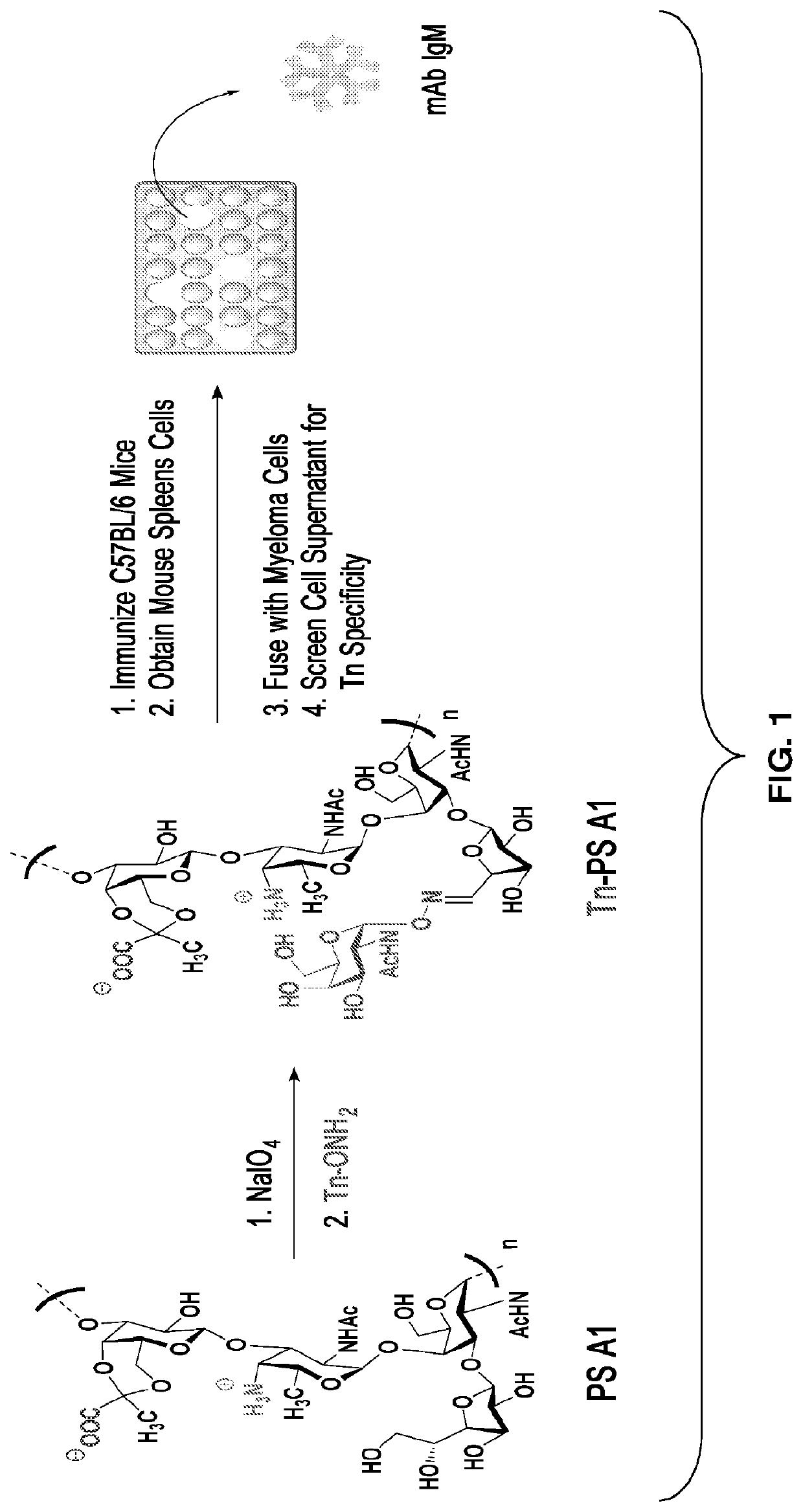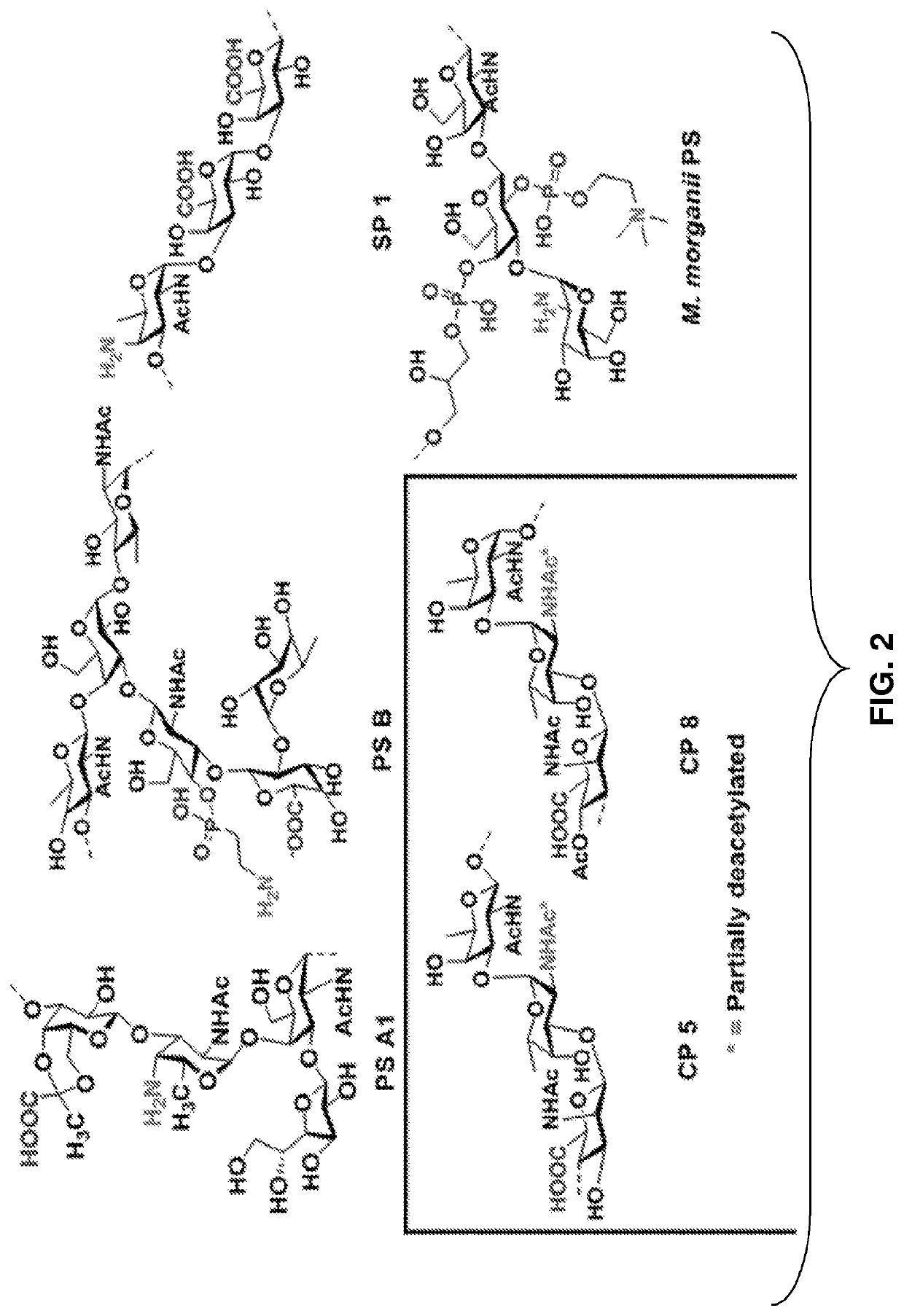Monoclonal igm antibodies from entirely carbohydrate constructs
a monoclonal igm and construct technology, applied in the field of monoclonal igm antibodies from entirely carbohydrate constructs, can solve the problems of carbohydrate epitope immunological nature, tacas cannot elicit strong t cell dependent immune responses, heterogeneity and ambiguity of chemical composition
- Summary
- Abstract
- Description
- Claims
- Application Information
AI Technical Summary
Benefits of technology
Problems solved by technology
Method used
Image
Examples
example 1
as an Entirely Carbohydrate Immunogen: Synthesis and Immunological Evaluation
[0106]Sialyl Tn (STn) is a tumor associated carbohydrate antigen (TACA) that is overexpressed in a variety of carcinomas such as breast, ovarian, and colon cancer. In normal tissue, STn is not detectable, which is important for opportunities in developing cancer immunotherapies. An entirely carbohydrate, semi-synthetic STn-PS A1 conjugate was prepared and evaluated in C57BL / 6 mice. STn-PS A1 was combined with commercially available monophosphoryl lipid A (MPL)-based adjuvant and after immunization, ELISA indicated a strong immune response for inducing both anti-STn IgM / IgG antibodies. The specificity of these antibodies was concomitantly investigated using FACS analysis and the results indicated excellent cell surface binding events to STn-expressing cancer cell lines MCF-7 and OVCAR-5. Most importantly, the raised antibodies conferred complement-dependent cellular cytotoxicity against MCF-7 and OVCAR-5 cel...
example 2
g Immunogenicity of the TF-Antigen by Targeting MGL2 Receptors Using a Bivalent Tn-TF-PS A1 Conjugate
[0132]In this Example, the importance of cancer vaccine design and development is demonstrated through an immunological investigation of monovalent Tn- and TF-PS A1 constructs, leading to a unimolecular Tn-TF-PS A1 bivalent immunogen which significantly increases immunogenicity towards the TF antigen. This additive Tn effect was also demonstrated to have enhanced IgG binding to tumor cell lines MCF-7 and OVCAR-5 in FACS analysis, and very good cytotoxicity in a CDC assay that monitored the expulsion of LDH. The enhanced immunogenicity was deciphered through studying the interaction of Tn-TF-PS A1 biotinylated probes binding to C-type lectin receptor MGL2.
[0133]PS A1, a zwitterionic capsular polysaccharide isolated from the commensal bacteria Bacteroides fragilis ATCC 25285 / NCTC 9343, initiates CD4+ T cell responses. The current understanding of zwitterionic polysaccharides as immune ...
example 3
Growth and Isolation, and Purification of PS A1
[0182]B. fragilis (ATCC 25285 / NCTC 9141) was purchased from Presque Isle Cultures. To begin the initial growth procedure, the bacteria were streaked on blood agar-containing BBE plates. The plates were prepared in an anaerobic glove bag in a CO2 environment. After the cultures were initiated, the plates were transferred to an anaerobic jar with gas packs in the presence of O2 indicator strips and placed in an incubator at 37° C.
[0183]PYG broth was used for the growth of B. fragilis. Proteose-peptone (20 g), yeast extract (5 g), NaCl (5 g), and 0.001 g of reazurin per 1 L of nanopure H2O were autoclaved. Glucose 25% (2 mL), potassium phosphate 25% (2 mL), cysteine 5% (1 mL), 0.5% of hemin in 1N NaOH (100 μL), and 0.5% vitamin K1 in absolute ethanol (50 μL) were filtered using a 0.22 μm filter, and added to the autoclaved PYG broth. Anaerobic conditions were achieved by degassing solutions for 30 min under an atmosphere of 80% N2, 10% CO2...
PUM
| Property | Measurement | Unit |
|---|---|---|
| temperature | aaaaa | aaaaa |
| molar ratio | aaaaa | aaaaa |
| molar ratio | aaaaa | aaaaa |
Abstract
Description
Claims
Application Information
 Login to View More
Login to View More - R&D
- Intellectual Property
- Life Sciences
- Materials
- Tech Scout
- Unparalleled Data Quality
- Higher Quality Content
- 60% Fewer Hallucinations
Browse by: Latest US Patents, China's latest patents, Technical Efficacy Thesaurus, Application Domain, Technology Topic, Popular Technical Reports.
© 2025 PatSnap. All rights reserved.Legal|Privacy policy|Modern Slavery Act Transparency Statement|Sitemap|About US| Contact US: help@patsnap.com



